Which Couplers Are Best? OO Gauge Rail Review
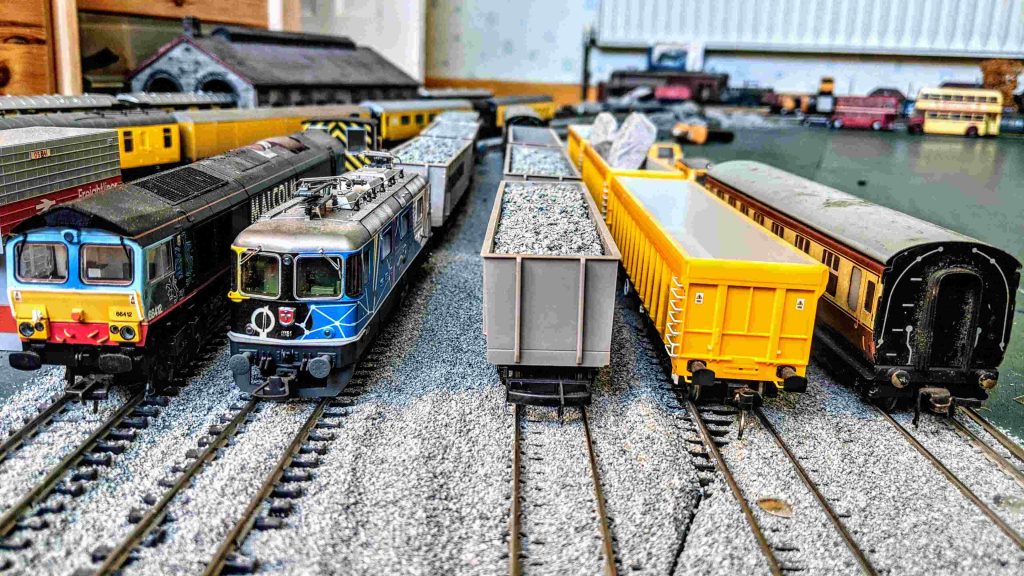
Railway couplers play an integral role in not just in the real world, but in railway modelling too. Regardless of how long you’ve been running trains on your own or your model railway club’s layout, you have no doubt, at some point, came across issues with your couplings. I have owned my stock for around 15 years now, but a lot of it dates back to 1970s and some go back to 1960s Triang stuff.
If you’ve been rail modelling for a while, you may have discovered that there are a handful of OO gauge rolling stock couplers. It can be a tough choice deciding which couplings to use, as each of them have their own drawbacks and advantages.
Below I will discuss 5 different types of rail couplings used on HO and OO gauge models, including other variations of these gauges such as 0n30 Narrow Gauge. The information described in this post are of my own opinions and experiences and are not a warranty or guarantee of the effectiveness of the couplers.
The couplings looked at are:
- NEM narrow loop couplers.
- NEM D loop couplers, including the older D loop couplers that were screwed to the chassis of older stock before NEM came into existance.
- Kadee HO Couplers.
- Dublo older style buckeye couplers.
- D Link Coupler (usually used on European stock by Roco).
I haven’t included drawbar couplings as these are only usually used between wagon pairs or multiple units. I haven’t included chain couplings as these are generally used for detailing and not strong enough to cope with weight of consists.
NEM Narrow Loop Couplers

As seen on the photograph above, pictured on the class 08 shunter is a NEM narrow loop coupler. It is now produced as standard on all British OO gauge stock from manufacturers such as Hornby, Dapol and Bachmann.
As standard in most newer stock and locomotives, an NEM pocket is fitted to the vehicle. NEM is becoming a widely recognised method of couplings for model railways, and as a result, most other types of coupling are manufactured with NEM pockets in mind. This makes it easy to change between couplers in a matter of seconds.
Advantages of NEM Couplers
NEM Couplers are shipped as standard in nearly all modern rolling stock and locomotives by most manufacturers for OO gauge products. As a result, they provide the essential job of connecting rolling stock together at no extra charge. They get the job done and connect the vehicles together well.
NEM Couplers can also withstand reasonable loads too and can haul at least 20 vehicles without detaching from the pocket.
There are also a variety of peripheral items such as track and tools that can automatically uncouple NEM narrow couplings, as well as the larger D loop (large) NEM Couplers.
Disadvantages of NEM Couplers
One thing that you may notice straight away from the above photo, is the fact that there is no hook on the photographed coupler. This is just one of the drawbacks of the NEM style couplings, because as the hooks tend to click into place on the coupler, they detach just as easily as they attach. As a result they can end up getting lost on your layout, or get mangled in a vehicle’s bogie and cause a short circuit.
Another disadvantage of NEM Couplers is that they are very poor when shunting.
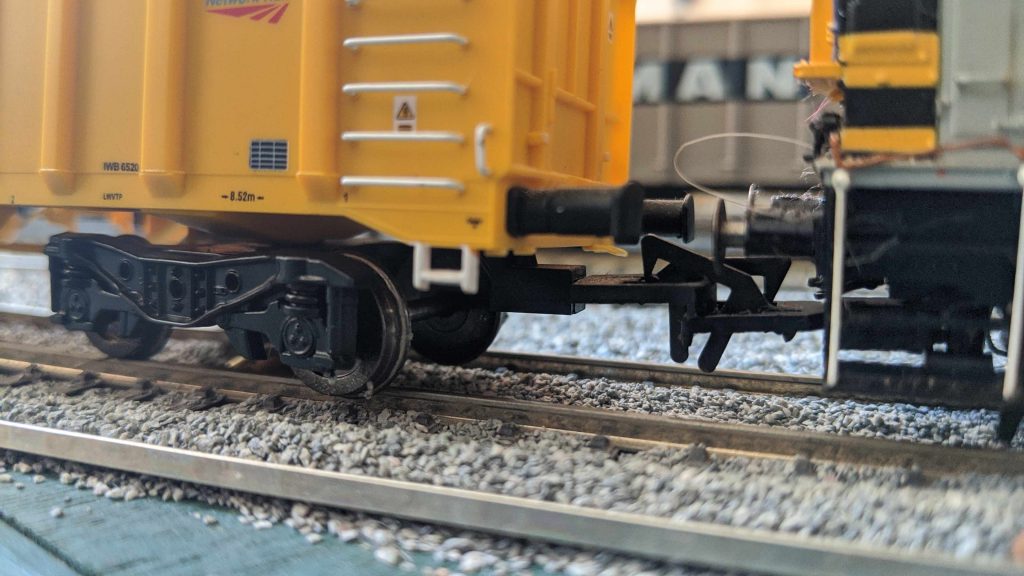
Due to their thin construction, NEM couplings tend to get caught underneath the coupler of the vehicle being shunted. As a result, it can bring the shunting vehicle closer to the wagon, lift it off the track and cause it to derail, or on curves, lead to the buffers faces becoming locked, again leading to derailment.
Another disadvantage, similarly with the larger NEM couplings and D loop couplers, they can be incredibly fiddly to uncouple. Luckily there are tools that can achieve this, such as by putting a file between the two vehicles and simply lifting the hooks.
For the novice railway modeller, NEM couplings are good and provide the essential link between stock. For the avid rail enthusiast, these are no good for shunting and cause the couplers to overlap and derail.
Personally I have started moving away from NEM couplings, but my layout has a large amount of older Hornby and triang stock with fixed couplers, I keep a coupler translator wagon handy.
NEM D Loop Couplers including older D shaped couplings with tension hooks

Unlike the narrow NEM tension hook couplings, the D loop ones are much wider, and were around a lot longer than the most recent NEM ones. D loop couplers date as far back as Triang in the 60s. Before then, Triang used a buckeye style coupling (like on the Dublo models) but it had a hook as well to lock the couplings in place.
Advantages of D Loop Tension Hook Couplers
The older D loop couplers are a lot more reliable when shunting in contrast to the thinner, shallower narrow NEM couplings, mostly because of their thickness and size that they don’t ride/overlap and cause derailment. They’re also a lot stronger and the tension hooks don’t come off as easily.
Another advantage is that they work well (when hauled) by the newer narrow NEM couplings. So you don’t need worry about replacing them with newer couplings. They will of cause suffer from the narrower, modern NEM couplings overlapping when shunting, but this isn’t an issue with the D loop couplers themselves, instead a disadvantage of the narrow ones.
Disadvantages of D Loop Tension Hook Couplers
The main disadvantage is that they are unsightly. They are large and whilst they get the job done, they’re not realistic and because they were fitted to a lot of Hornby stock after Dublo, all the way through up until after 2010 when they were still fitted to Hornby Railroad stock and locomotives. One of the main issues is that they can be a pain to remove as well, usually requiring surgery to fit a more modern coupling. As seen in the wagon photograph at the top of this section, they are fitted to the bogie and you’d need some sort of conversion or adapter to be able to fit any other type of coupling. Some older models had the couplings screwed on so removal was just a simple case of unscrewing it off, but then the issue of fitting a replacement still existed.
Overall, the D loop older couplers are fantastic if you’re not bothered about realism. They provide good strength and can withstand any number of vehicles in a rake.
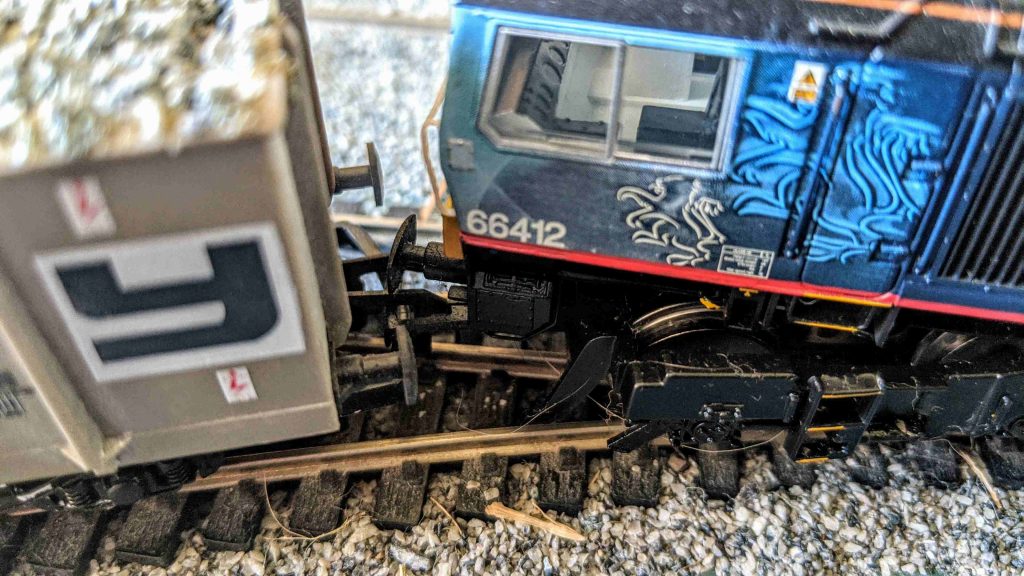
They don’t suffer from overlapping when shunting either, and their rounded shape means that they run well around corners shunted too. For performance they’re definitely a 4/5 (you can still end up losing the hooks, which is a pain). In terms of realism, they’re not so great, but its likely it doesn’t matter, because they’re only fitted on cheaper models without great detailing anyway.
Kadee Buckeye Couplings
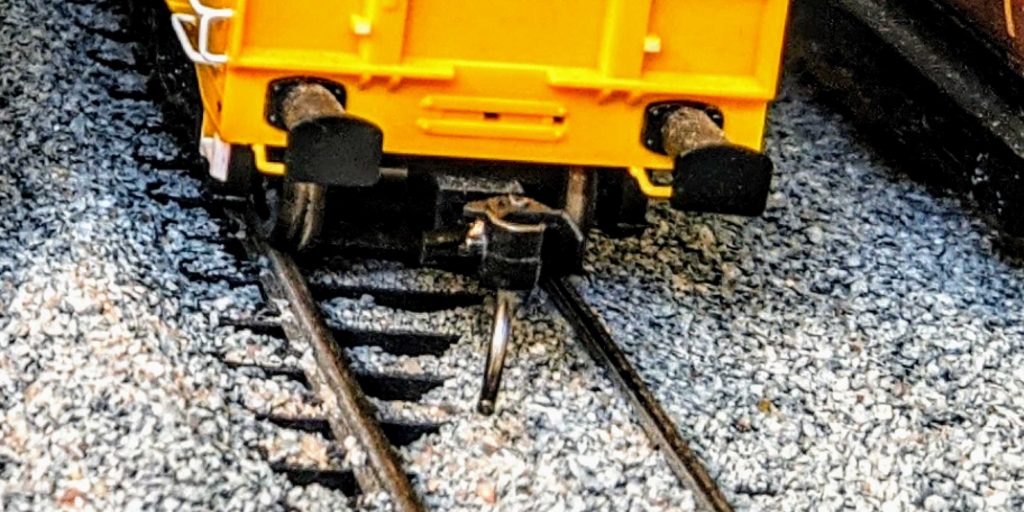 Kadee couplings provide good tension between rolling stock and are fitted as standard on most HO gauge and 0n30 vehicles. Kadee provide these couplings in various lengths for short and extra long connections between vehicles. The buckeye couplings are typically sold either to fit in NEM pockets (which is good for when you want to move away from the narrow NEM couplings), or they come with a hole in the end for you to screw onto the chassis. Kadee sell these NEM buckeye couplings for around £5.50 per pack, and a pack usually contains 2 pairs (4 couplings).
Kadee couplings provide good tension between rolling stock and are fitted as standard on most HO gauge and 0n30 vehicles. Kadee provide these couplings in various lengths for short and extra long connections between vehicles. The buckeye couplings are typically sold either to fit in NEM pockets (which is good for when you want to move away from the narrow NEM couplings), or they come with a hole in the end for you to screw onto the chassis. Kadee sell these NEM buckeye couplings for around £5.50 per pack, and a pack usually contains 2 pairs (4 couplings).
Advantages of Kadee Buckeye Couplers
These types of buckeye couplers have many benefits over the other types of couplings outlined in this article. For starters, they are usually sold as an NEM fitting, that go into the NEM pockets of most modern rolling stock and locomotives by Hornby, Bachmann, Dapol and Heljan. For international models, other manufacturers of these couplings supply them with a hole in the end, to work with Walthers, Athearn etc.
Aforementioned, they come in a variety of lengths as well, for close coupling stock (like coaches), to larger lengths where the bogie NEM pocket is further away from the gangway.
These couplings have very good tension and couple together easily (on straight track). They are also considerably more realistic compared to all other couplings outlined in this article – just take a look at this class 73 below – none of the other couplers compare.
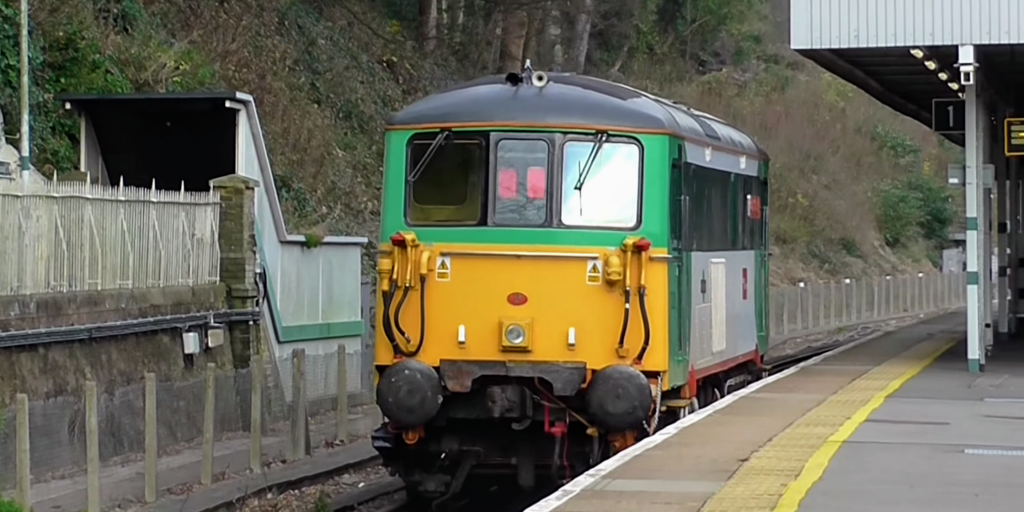
The buckeye couplings are probably the best to work with, but they do have their disadvantages.
Disadvantages of Kadee Buckeye Couplers
There are a few disadvantages which shouldn’t be missed when considering upgrading to these couplings.
Whilst their size is also a benefit of making them more realistic and aesthetic, they’re also very delicate. They have a very small spring which makes the coupler knuckle open and close. It’s easy to accidentally knock the spring out and lose it (for example dropping it, or when trying to squeeze the coupler drawbar into the NEM pocket), causing the spring loaded knuckle to no longer open/close as easily.
Some of the issues with NEM pockets fitted to stock is that they aren’t always the same height (and we look at this issue in more detail on the next section’s disadvantages). As a result, the couplings can slip out and uncouple when they’re not equal height. If you’ve got any imperfections in rail height (eg, on one side of some track the rail may have come out of the sleeper fastenings leading to one side higher than the other) then the couplings may separate too.
Another disadvantage is that they’re fitted with a manual uncoupling hook which hangs down beneath the coupling, and the problem with this is that it can get caught on pointwork and things like foot crossings. If you use drawing pins to tack your track down (like I do, because they’re easier to pull out if I need to do track renewal), then they can also get caught on these and cause either damage to the coupler, or derail the train. Although they don’t hang that much further than NEM tension hooks, so if it was causing you trouble, a pair of wire cutters can be used to trim it or remove it completely.
The Kadee couplers are also a bit of a pain to uncouple. You have to lift the vehicle out so that the knuckles seperate. I believe they are magnetic, but I don’t find any easy way to uncouple them. You may have better luck but it would seem you need to purchase an uncoupler accessory.
Overall, the Kadees are very good, very reliable, very strong and much more realistic than the other types of couplers but as with anything, they do have their disadvantages.
Dublo Style Buckeye Couplers
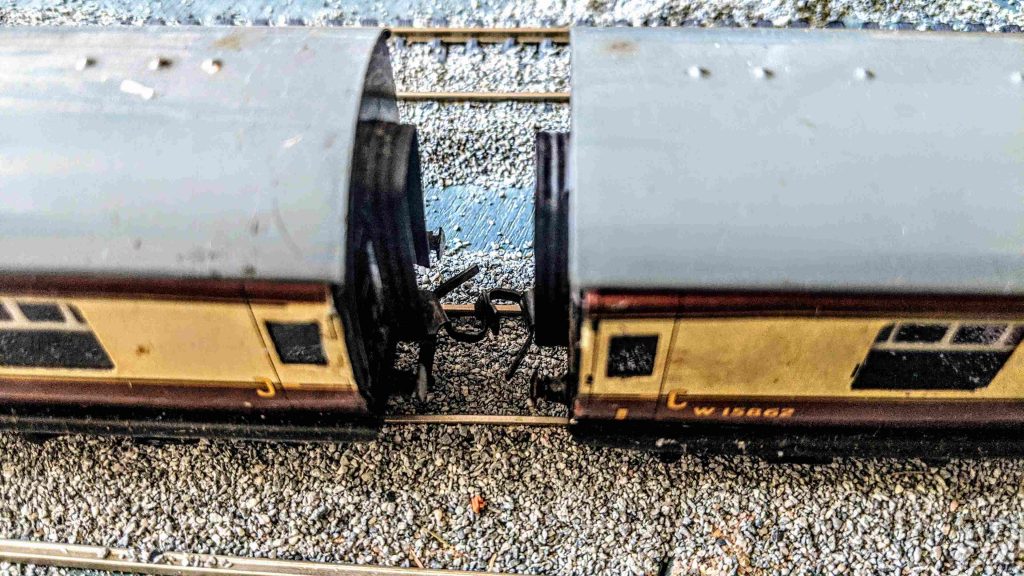
The metal dublo couplers were fitted to most tinplate stock many years ago and are no longer manufactured. A plastic type of buckeye coupler was produced in America by various manufacturers and was fitted to many types of models. It doesn’t look anything like the above but it works well with it.
Advantages of Dublo Metal Couplers
The Dublo metal couplings are strong (albeit can be adjusted with a bit of force) and if the locomotive is capable, the couplings can withstand quite a few vehicles in consist.
Provided that they are in good shape, it is easy to couple and uncouple, as they can be moved with a screwdriver (or other long, thin object) to the left or right to engage the couplings. To uncouple, it is as easy as lifting the vehicle out of the coupling, or putting some slack between the vehicles and again, using the screwdriver to move the couplings out of position.
Disadvantages of Dublo Metal Couplers
Unless you’re running a 3 rail layout, or have an interest in keeping your old stock running (with refitted wheels that don’t short 2 rail track), it’s unlikely you’ll ever need to use these couplers as they’re very outdated. No new models are fitted with these couplings.
Another disadvantage is that they don’t couple well simply by pushing two vehicles together. You typically need to fiddle with them to get them coupled. Seen in the photograph above, the two coaches, when pushed together don’t couple. They need lifting in. It’s possible by twisting the metal in such a way that it would, but thereafter, you may end up needing to adjust it again to work with other vehicles.
Similarly with the Kadee couplings, if you have imperfections in rail height or not all track is level, the couplings may separate.
It’s best to avoid these older couplings as they’re not really useful anymore and there are better alternatives out there. On older tinplate coaches like the above, they were usually fastened to the bogie or riveted to the chassis making switching couplers a pain.
D Link Couplings
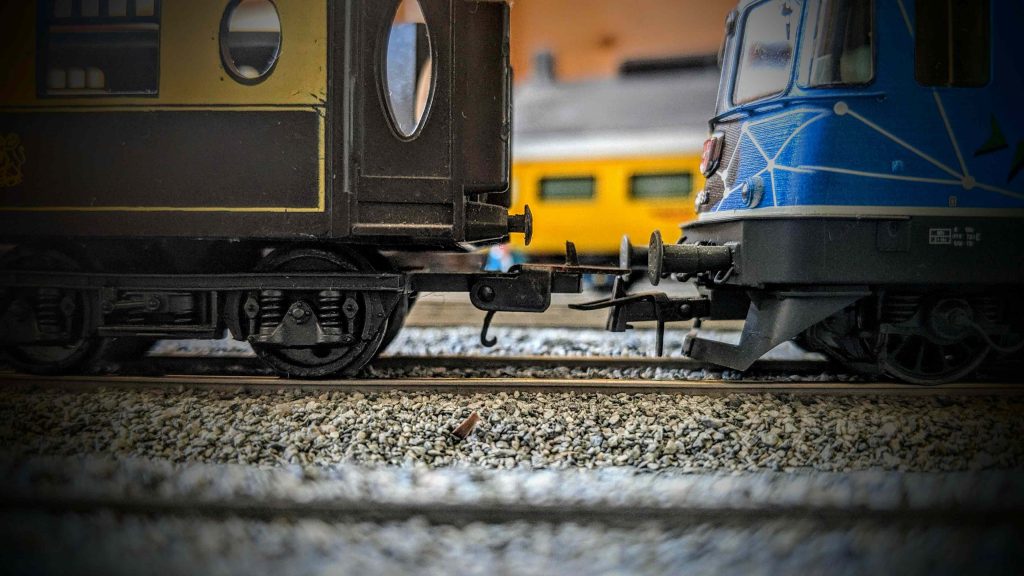 D Link Couplings are usually sold on European locomotives and stock manufactured by Rocco, Joueff amongst others. Prior to interior lighting, they were also used for coupling multiple units released by Bachmann. Citation needed, lima may have also used these couplers – if not, I am not sure why my pullman coach above is fitted with them.
D Link Couplings are usually sold on European locomotives and stock manufactured by Rocco, Joueff amongst others. Prior to interior lighting, they were also used for coupling multiple units released by Bachmann. Citation needed, lima may have also used these couplers – if not, I am not sure why my pullman coach above is fitted with them.
D Loop couplers consist of a loop which links onto a hook on the opposite vehicle. They interlock, making connection very secure.
Advantages of D Link Couplers
D link couplers can be purchased to fit into NEM pockets, which means it is easy to replace your existing NEM couplings with D links. They provide a good connection between rolling stock as variations in coupler height can usually be overlooked because a hoop can be lifted onto a higher hook. This may not be such a good idea for heavier loads but it would get the job done.
All in all, they’re a good alternative to NEM pockets.
Disadvantages of D Link Couplers
They can also overlap, similarly to the NEM narrow couplings, when shunted. Especially when the couplings aren’t equal height as seen in the photo above.
Also, the D Link couplers don’t look realistic. In conclusion, they’re about as good as the NEM narrow couplers, but with an extra bit of security in that the hoop keeps the couplings locked in place more reliably. The hoops rarely detach from the coupler so you won’t have the same issues as with the D style NEM and narrow NEM’s tension hooks.
Unfortunately with all NEM couplings, they can be a pain to remove from the pocket. They are kept in place by two bulges on the ends of the couplers which can be pressed together to release the tension, before being pulled out. I hope this article has been of interest.
In conclusion, the best coupling for performance, appearance and durability, would be the Kadee buckeye. It comes in varying lengths, and makes models look a lot more realistic. It’s only to be expected, as Kadee specalise in model railway couplings of many gauges, whereas the other couplings are a standard between manufacturers.
- The NEM loops overlap and cause derailments when shunting and don’t look particularly realistic. They’re good for entry level railway modelling.
- The D loop couplings as used on most Hornby/Bachmann Branchline models between 1960s and 2000s provide a stronger connection between stock and are better for shunting than the above, but they are even lesser realistic and on older stock, a pain to replace.
- The Kadee Couplers are much more realistic than all others (probably because Kadee specalise in couplings and their business relies on their products), they look good, and they provide excellent coupling between stock. They do however, rely on the couplings being the equal height on both bogies otherwise they’ll slip out and uncouple.
- The Dublo metal couplings, and the newer plastic buckeye counterparts, don’t work particularly well and uncouple too easily.
- The D Loop couplings are good but again, rely on the bogies and coupling pockets to be equal height.
NEM is the new standard for coupler fittings, so it is best to buy either D link or Kadee couplers if you wish to move away from the narrow NEM couplings. You can buy Kadee NEM buckeyes from Gaugemaster for around £5.50 for 2 pairs / 4 couplers.
Please do not hesitate to share your opinions below, and if anything is wrong in the article please let me know and I will tweak. Rail Record is predominantly a live train times website but our writers also express interest in the latest rail news and rail modelling on the Rail Record blog like on this page.
Sir,
I amre-instating my old OO railway. In the early 80s I built several Ratio kits, These were very nice models but the couplings were very fragile. Which modern couplings should I replace them with please.
veryinteresting
Very good, but you have confused the mounting type eg, NEM with the coupling type.
Mostly you mixed up tension lock ie, the curved hook over a bar store with how it’s fixed to the chassis.
Tension lock refers to the old D bar moulded on the wagon, never where it was screwed on (a couple of different types) & the narrow version.
Most new stock now mounts the coupling in an NEM pocket, to allow the easier changing of coupling type, so the kadee 17/18/19 range are NEM pocket mounted versions of their buckeye.
As relevant as looks are how it operates though – of the types listed only kadee have a delayed action to allow prototypical shunting.
Other delayed types are available (as are less intrusive looks) but you get into kit building – good to mention that they exist though (eg, Alan Jackson, Dingham, Spratt & Winkle, DG coupling)
Staying with tension lock you might look at Brian Kirby mod to allow under track magnets to uncouple.
Thanks for this article, Matt.
So informative with a fine analysis of the various choices.
Decision now made.
Nice injection of humour as well – made me smile.